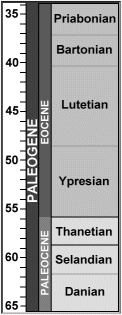| |
Cappetta & Nolf (2005) erected this genus for teeth previously ascribed to Carcharias teretidens. First described by White (1931) as Odontapsis (synodontaspis) cuspidata (Agassiz), praemut. teritidens, Nolf (1986) ascribed them to Synodontaspis teritidens where they remained until the 1987 ICZN ruling; thereafter they were attributed to Carcharias.
 Teeth now referred to as Sylvestrilamia teretidens have been reported from the Palaeocene and early Eocene of Western Europe and North America. In the Chesapeake Bay region, they have been reported by Kent (1994) from the Aquia (Upper Palaeocene) and Kent (1999) from the Nanjemoy (Early Eocene - Ypresian) Formations.
Teeth now referred to as Sylvestrilamia teretidens have been reported from the Palaeocene and early Eocene of Western Europe and North America. In the Chesapeake Bay region, they have been reported by Kent (1994) from the Aquia (Upper Palaeocene) and Kent (1999) from the Nanjemoy (Early Eocene - Ypresian) Formations.
Within these Western Atlantic Paleogene sediments, there are five reported sand tiger-like taxa that bear or may bear striations on their lingual crown face:
Anomotodon novus (WINKLER 1874) (a goblin shark), Barchycarcharias lerichei (CASIER, 1946),
Striatolamia spp.,
Sylvestrilamia teretidens (WHITE, 1931) and the mysterious (at least to us)
"Carcharias" whitei (ARAMBOURG, 1952) which was not addressed by Cappetta & Nolf (2005). For identification purposes, the lack of cusplets (Anomotodon) and multiple cusplets per side (Barchycarcharias) helps to exclude many possiblities. Most Striatolamia tooth-positions are quite distinct, further narrowing the possibilities. Using this filtering process, likely candidates for teretidens-like teeth can be established.
Written descriptions (i.e., Kent or Cappetta & Nolf) of these and most teeth are usually of marginal value and only serve well when accompanied by images that will allow the reader to interpret ambiguous (slightly, relatively, obtuse, very, etc.) observations. The senior author is in the process of reconstructing a tooth-set; but the 'process of elimination' and the below images will need suffice at this time.
Selected References
Cappetta, H & Nolf, D, 2005. Revision de quelques Odontaspidae (Neoselachii: Lamniformes) du Paleocene et de l'Eocene du Bassin de la mer du Nord Bulletin de l'institut Royal des Sciences Naturelles de Belgique, Sciences de la Terre 75:237-266.
Kent, B.W. 1994. Fossil Sharks of the Chesapeake Region. 146 pp. Egan Rees & Boyer, Maryland.
Kent, B.W. 1999. Sharks from the Fisher/Sullivan Site. In: Early Eocene Vertebrates and Plants from the Fisher/Sullivan Site (Nanjemoy Formation) Stafford County, Virginia, Weems, R. & Grimsley, G., 1999.
Virginia Division of Mineral Resources, Pub 152. pp 11-38.
Nolf, D., 1986. Fossielen van Belgie. Haaie- en roggetanden uit het Tertiar van Belgie. Institut royal des Sciences naturelles de Belgique, 170 p.
White, E.I., 1931. The vertebrate faunas of the English Eocene. I. From the Thanet Sands to the Basement Bed of the London Clay. British Museum (Natural History), 121 pp.
|